LG G2 and MSM8974 Snapdragon 800 - Mini Review
by Brian Klug on September 7, 2013 1:11 AM EST- Posted in
- Smartphones
- LG
- Mobile
- LG G2
- Android 4.2
- MSM8974
- Snapdragon 800
Battery Life
One of the things Qualcomm promised would come with Snapdragon 800 (8974) (and by extension the process improvement with 28nm HPM) was lower power consumption, especially versus Snapdragon 600 (8064). There are improvements throughout the overall Snapdragon 800 platform which help as well, newer PMIC (PM8941) and that newer modem block onboard as well, but overall platform power goes down in the lower performance states for Snapdragon 800. In addition the G2 has a few unique power saving features of its own, including display GRAM (Graphics RAM) which enables the equivalent of panel self refresh for the display. When the display is static, the G2 can run parts of the display subsystem and AP off and save power, which they purport increases the mixed use battery life case by 10 percent overall, and 26 percent compared to the actively refreshing display equivalent. In addition the G2 has a fairly sizable 3000 mAh 3.8V (11.4 watt-hour) battery which is stacked to get the most out of the rounded shape of the device, and utilizes LG's new SiO+ anode for increased energy density compared to the conventional graphite anode.
Our battery life test is unchanged, we calibrate the display to exactly 200 nits and run it through a controlled workload consisting of a dozen or so popular pages and articles with pauses in between until the device dies. This is repeated on cellular and WiFi, in this case since we have an international model of the G2 that lacks the LTE bands used in the USA, that's 3G WCDMA on AT&T's Band 2 network. I've tested 3G battery life on devices concurrently for a while now in addition to LTE though, so we still have some meaningful comparisons. The most interesting comparisons are to the Optimus G (APQ8064) and HTC One (APQ8064T) previous generation.
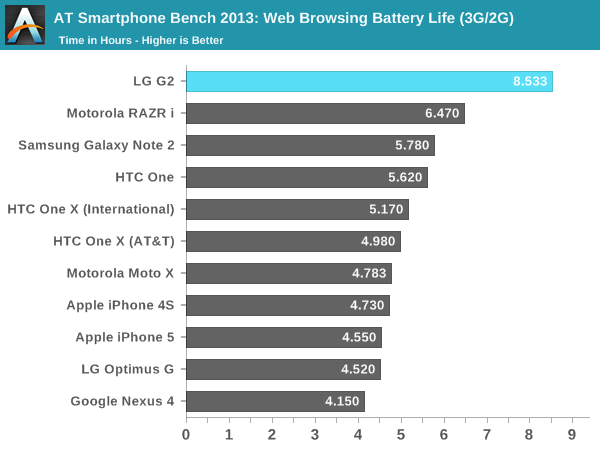
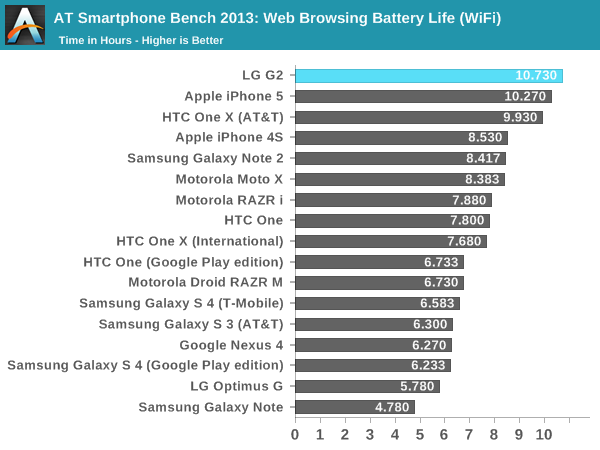
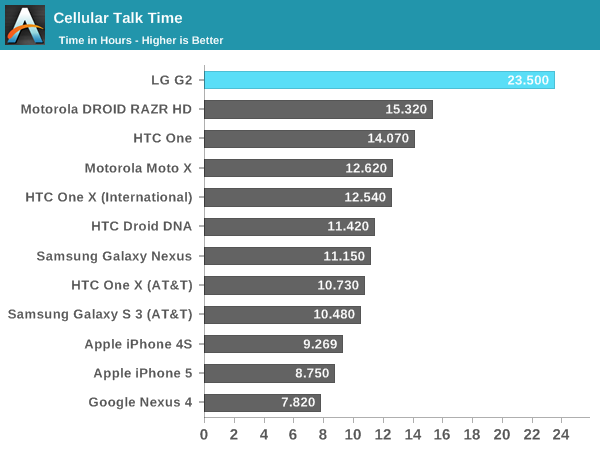
The LG G2 battery life is shockingly good through our tests, and in subjective use. The combination of larger battery, GRAM for panel self refresh, new HK-MG process, and changes to the architecture dramatically improve things for the G2 over the Optimus G. While running the two web browsing tests I suspected that the G2 might be my first phone call test to break 24 hours, while it doesn't break it it comes tantalizingly close at 23.5 hours. I'm very impressed with the G2 battery life.
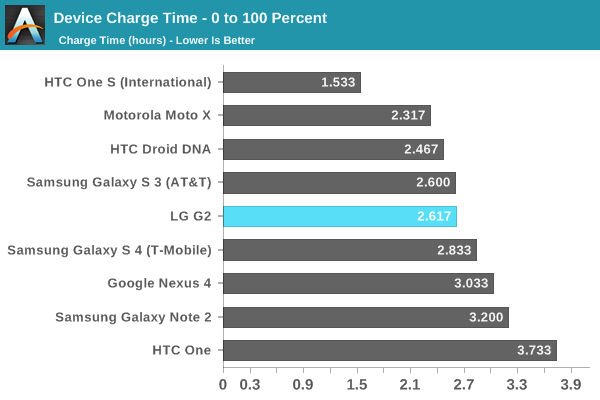
The G2 also charges very fast for its battery size. I've been profiling charging behavior and current for devices for a while now, since I strongly believe that battery life and charging speed are complementary problems. You should always opportunistically charge your smartphone, being able to draw as much while you have access to a power outlet is critical. The G2 can negotiate a 2A charge rate on my downstream charge port controller and charges very fast in that mode. Of course the PM8941 PMIC also includes some new features that Qualcomm has given QuickCharge 2.0 branding.


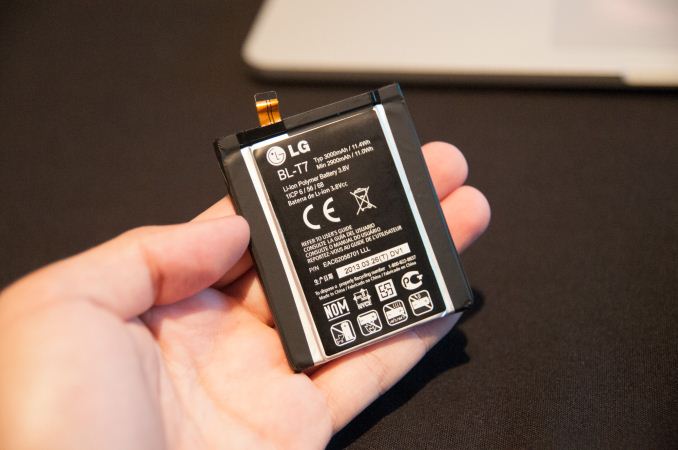








120 Comments
View All Comments
Impulses - Sunday, September 8, 2013 - link
In addition to some of the headphone jack and audio performance someone asked about, a note on speakerphone volume would be nice. I don't think the review even mentioned where it's located (though I'm guessing it's on the bottom edge from the pics I remember glancing at, I wish there wasn't so much click thru required to browse those on mobile btw).Gondalf - Sunday, September 8, 2013 - link
Yes this is a mini review but the battery life benches are pointless. Obviously with a 3Ah battery the Web Browsing result and talk time are very good, considering that the soc is mostly idle or at low clock speeds. No mention about battery life under gaming or other serious usages...this is a pity because the worst defect of these superphones is the very low battery life under stress.I think that Anandtech must to discover the bad side of a device, not only show the points in favor. I have the suspect LG has made an agreement with this web site.
Anyway a so power hungry Soc in a phone is a nonsense that can give many reliability issues to the customers.
Bad review this time, so sorry
Krysto - Sunday, September 8, 2013 - link
That's a good point. I guess the only one that comes close to "real world usage" is the browsing one. Even the video one is not that accurate since it will mainly use the GPU or video accelerator, and you're not going to do video on your phone all the time anyway.tuxRoller - Tuesday, September 10, 2013 - link
Yeah, AT clearly has taken the monies from LG to promote their products.From know on it's going to be 24/7 LG!
coachingjoy - Sunday, September 8, 2013 - link
With a desktop I would think a 2560x1440 display would be warranted.It makes a desktop worthwhile.
I mean, why not use a phone/notebook/laptop instead?
coachingjoy - Sunday, September 8, 2013 - link
ha, my bad. wrong thread.Krysto - Sunday, September 8, 2013 - link
Shocking how good Moto X's EIS was. I wonder if they're using the same stabilization algorithms as the ones Youtube implemented a while ago. It does seem to be about as amazing as that one.Lumia 1020 was definitely the worst. It was jittery through and through.
The order from best to worst was like this
#1 Moto X (virtually perfect)
#2 Lumia 925 (quite smooth, but with some "movements")
#3 HTC One (a little more of those "movements")
#4 LG G2 (not bad, but jittery from time to time)
#5 Galaxy S4 (meh, pretty bad, its EIS doesn't help much)
#6 Lumia 1020 (terrible, almost as if it had no stabilization)
AbbyYen - Sunday, September 8, 2013 - link
is it because MOTO X use dual core 320 so it fare so well compare to 330?ArmedandDangerous - Sunday, September 8, 2013 - link
The HTC One with the newer HBOOT 1.54 has QuickCharge enabled, so it's very much faster than it was at launch now :)Davidjan - Monday, September 9, 2013 - link
Still does not it support OTG? Don't know why it disables power supply for OTG in some module of smartphone like Nexus 4, LG G. If it enable power supply, then can easily extend storage with this mini reader: http://goo.gl/U6IyY